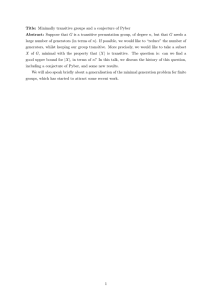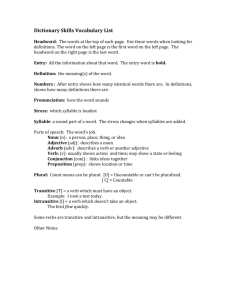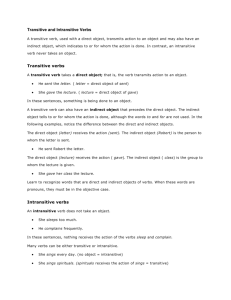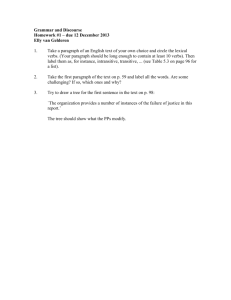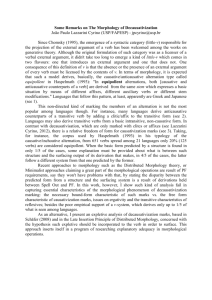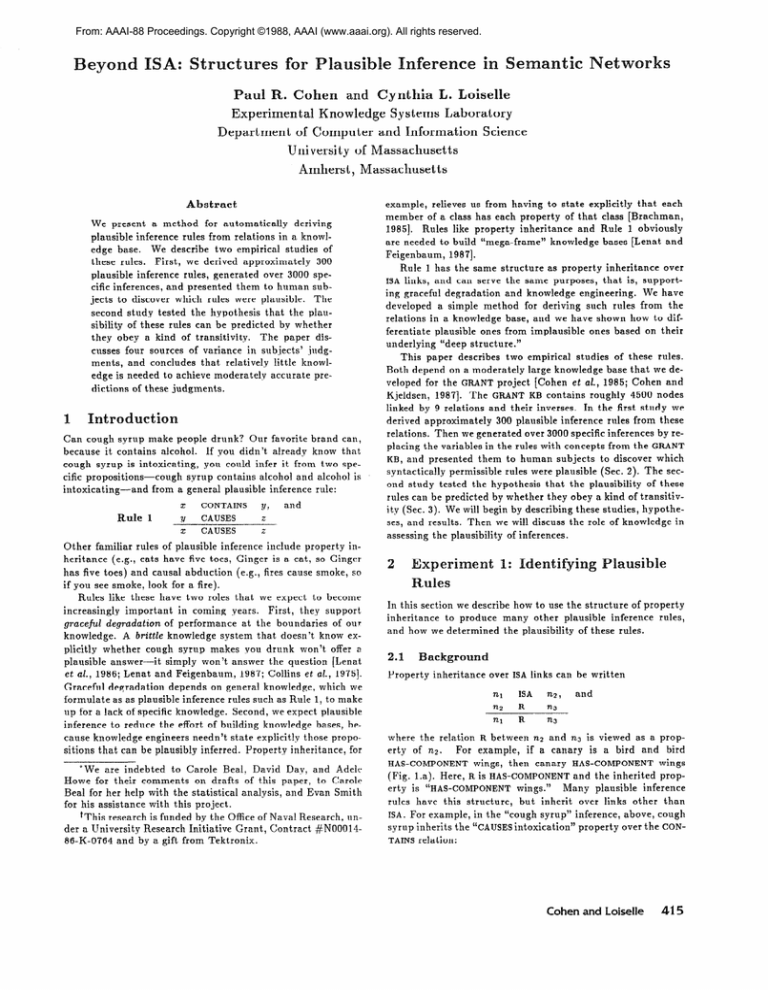
From: AAAI-88 Proceedings. Copyright ©1988, AAAI (www.aaai.org). All rights reserved.
eyornd HSA: Structures
Paul R.
Cohen
Experimental
Depaztment
and
Knowledge
of computer
University
present
a method
for
inference
rules
We describe
base.
edge
these
First,
rules.
automatically
we derived
jects
to discover
second
study
sibility
they
which
tested
of these
obey
cusses
four
ments,
and
dictions
Introduction
Can
cough
syrup
that
make
people
rules
(e.g.,
has five toes)
Rules
increasingly
plicitly
X
CONTAINS
y,
CAUSES
z
2
CAUSES
t
two
cause
sitions
to reduce
that
can,
and alcohol
is
rule:
and
structure
1 obviously
bases
as property
[Lenat
and
inheritance
over
the same purposes,
that is, supportand knowledge
engineering.
We have
describes
smoke,
so
based
on their
them
inverses.
In the
inference
over 3000 specific
to human
permissible
3). We will begin
Then
subjects
the plausibility
2
periment
Cohen
4500
first
rules
and
nodes
study
from
inferences
we
these
by re-
from the GRANT
(Sec.
2).
which
The
sec-
that the plausibility
of these
they obey a kind of transitiv-
by describing
we will discuss
assessing
rules.
we de-
to discover
rules were plausible
ond study tested the hypothesis
rules can be predicted
by whether
that
roughly
in the rules with concepts
and presented
of these
base
et al., 1985;
contains
300 plausible
we generated
studies
knowledge
[Cohen
KB
and their
the variables
syntactically
large
GRANT
approximately
Then
ones
two empirical
project
The
by 9 relations
placing
implausible
on a moderately
19871.
relations.
KB,
ones from
for the GRANT
ity (Sec.
fires cause
Rule
structure.”
ses, and results.
that
we expect
years.
First,
knowledge
syrup
at the
system
makes
simply won’t
and Feigenbaum,
degradation
knowledge
(e.g.,
roles
depends
the effort
engineers
can be plausibly
In this section
support
of our
know
won’t
ex-
offer
a
the question
[Lenat
Collins et al., 19751.
knowledge,
which
inheritance
these
studies,
hypothe-
the role of knowledge
in
of inferences.
I:
we describe
to produce
Identifying
2.1
state
inferred.
knowledge
explicitly
Property
bases,
those
Property
inheritance
befor
*We are indebted
to Carole
Beal,
David Day, and Adele
Howe for their comments
on drafts of this paper,
to Carole
Beal for her help with the statistical
analysis,
and Evan Smith
for his assistance
with this project.
‘This research is funded by the Office of Naval Research,
under a University
Research
Initiative
Grant, Contract
#N0001486-K-0764
and by a gift from Tektronix.
of these
rules.
Background
over ISA links can be written
we
propo-
inheritance,
how to use the structure
of property
many other plausible
inference
rules,
the plausibility
and how we determined
rules such as Rule 1, to make
Second, we expect
plausible
of building
needn’t
doesn’t
you drunk
answer
1987;
to become
they
boundaries
that
on general
formulate
as as plausible inference
up for a lack of specific knowledge.
inference
paper
depend
veloped
brand
inference
Y
in coming
cough
plausible
answer-it
et al., 1986; Lenat
Graceful
alcohol
plausible
of performance
A brittle
whether
Our favorite
contains
abduction
have
important
knowledge.
drunk?
and
knowledge
look for a fire).
these
degradation
gracehE
“deep
Kjeldsen,
a general
and causal
like
pre-
of plausible
inference
include property
inhave five toes, Ginger is a cat, so Ginger
cats
if you see smoke,
This
Both
If you didn’t already
know that
you could infer it from two spe-
syrup
from
familiar
plausible
underlying
knowl-
accurate
inheritance
“mega-frame”
1 has the same
derived
Rule P
Other
moderately
19871.
ferentiate
disjudg-
little
Feigenbaum,
linked
cific propositions-cough
heritance
in subjects’
property
developed
a simple method
for deriving
such rules from the
relations
in a knowledge
base, and we have shown how to dif-
by whether
relatively
like
to build
links, and can serve
ing graceful degradation
plau-
paper
Rules
ISA
The
the
Science
are needed
Rule
spesub-
judgments.
because
it contains
alcohol.
cough syrup is intoxicating,
intoxicating-and
that
The
of variance
to achieve
1
plausible.
can be predicted
concludes
of these
were
hypothesis
Labora.tory
relieves us from having to state explicitly
that each
of a class has each property
of that class [Brachman,
19851.
300
over 3000
to human
of transitivity.
sources
edge is needed
rules
the
rules
a kind
deriving
approximately
Systems
and Information
example,
member
from relations
in a knowltwo empirical
studies
of
plausible
inference
rules, generated
cific inferences,
and presented
them
L. Eoiselle
Massachusetts
Abstract
plausible
Cynthia
of Massachusetts
Amherst,
We
antic Networks
for PBausible
where
erty
the
relation
of n2.
For
ISA
n2,
n2
R
n3
n1
R
723
R between
example,
wings,
HAS-COMPONENT
and
n2 and n3 is viewed
if a canary
then
canary
as a prop-
is a bird
and
HAS-COMPONENT
bird
wings
(Fig. 1.a). Here, R is HAS-COMPONENT
and the inherited
propMany plausible
inference
erty is “HAS-COMPONENT
wings.”
rules
ISA.
have
this
For example,
syrup inherits
TAINS
structure,
but
inherit
in the “cough
syrup”
the “CAUSES
intoxication”
over
links
inference,
property
other
above,
than
cough
over the CON-
relation:
Cohen and Loiselle
415
cough
syrup
alcohol
cough
Figure
syrup
1.b shows
premises
HAS-COMPONENT
alcohol,
CAUSES
intoxication
base
CAUSES
intoxication
pairs of relations
(including
relations
and an equal number of rules.
The
two other
but different
cloud”
COMPONENT
storm”);
the other
(and,
“rain
“storm
MECHANISM-OF
They
cloud”).
rain”
HAS-
COMPONENT-OF
rain” (and, equivnthe conclusions
arc
But
and “rain
Since
the same
is “storm
“cloud
MECHANISM-OF
HAS-MECHANISM
have
One premise
equivalently,
is “cloud
lently,
examples.
conclusions.
and
storm,”
COMPONENT-OF
each
pair of relations
constructed
from
nine
from
relations
Experiment
sible
rules
produce
I
over
-- - * - component
a.
Property
the
inheritance
over
ISA
component-of
mechanism-of
cloud
-
300
so (18’ + 18)/2
to the
thousands
the effort
then
was to generate
by chaining
GRANT
of first
storm
b.
Figure
This
rain
.Inferences
that
property
1:
Inheritance
illustrates
:
but,
generation
have
large
have the
inheritance
structure
inferences
Each
and structurally-identical
that
each
pair of relations
plausible
inference
rules that have the same
erty inheritance
over ISA links. For relations
rules
knowledge
can produce
two
are:
method
Rule 2
Rl
?xz,
n2
~2
nn
n1
R2
n3
tllld
nected
R2
=
1.b shows
these
1 introduces
R2-INV
R~,
RI-INV
n1
n3
RI-INV
nj
the
drawn
the conclusion
and is always
n2 = cloud,
as solid lines.
drawn
we will
The
+first
genernfion
inference,
“storm
and n3 = rain.
nse
throughout.
hypotenuse
as a dashed
represents
line.
MECHANISM-OF
as the premise of a. second generation
inference,
runoff.”
conclusion
“storm HAS-PRODUCT
mechanism-of
cloud
erain
rain
has-product
.-
*
.---has
.- -* product
.-
storm
storm.
First
rain,”
which
.fl
.--
.-- .
.-
generation
inference
Figure
Knowledge Representation
storm,
cloud,
rain”
serves
has the
runoff
test
inference
of relations
triples.
We
to be first
pair,
say HAS-
the GRANT
for
KB
and rain instantiate
l.b,
and
generation
with
yielding
“rain
test
is repeated
generation
item
during
the previous
the conclu-
COMPONENT-OF
items.
(though
test
yield
Procedure
Items
in the
a computer
data
set
were
program.
Next,
the
whether
set
or else to indicate
Each
item
sion with
that
was seen
20 items
judged
second
were
and
approximately
that
of each
was produced
the
of 3116
to
of which
test
human
asked
concluitems,
of
subjects
first
subjects
by
to indicate
were
from
Following
was in the
700 items
gen-
one or both were unone or both premises.
did not understand
by two subjects.
(none
generation
one premise
or did not follow
they
the
and half are second
presented
was shown
it followed
we add
KB.
not necessarily
a data
Subjects
conclusion
of
conclu-
item).
whether
both premises
were acceptable,
acceptable,
or they did not understand
judge
dozens
their
However,
that
which roughly half are first generation
eration items.2
2.3
yield
and
to generate
condition
search
rules
KB
five,
must be a conclusion
sion of a first generation
the 315
GRANT
select
to the GRANT
the added
second
In all,
in the
randomly
of al! the triples
procedure
items,
subject
Second
generation
inference
2: Second-generation
we pro-
and five second
For each
we search
in Figure
MECHANISM-OF
pairs
This
Rules can be chained by letting the conclusion
of one serve as
a premise for another.
Figure 2 shows how the conclusion
of a
416
“storm
conclusions
Rules are represented
as triangles
formed from three concepts
and three relations.
The legs of the triangle represent
premises,
and are always
For instance,
and n3, respectively
n2,
sions,
a11 d
for ~1 = HAS-COMPONENT,
notation
on two relations.
and MECHANISM-OF,
and 3, above).
Most
nz
n1 = storm,
MECHANISM-OF,
Figure
For each
KB.’
storm.”
m
alternatives
to judge.
to n3 by MECHANISM-OF).
Each triple represents
a pair
from which tvro inferences
can be drawn (see Rules 2
n1 ,n,z,nn
Figure
subjects
conclusions,
then present
of premises
siolls
and
Rule 3
to
bases.
triples of nodes nl,n2,n3
that are connected
by these relations
(i.e., nr is connected
to n2 by HAS-COMPONENT,
and n2 is con-
nl,
nl
very
or predict
a powerful
315 rules from the GRANT
rule is based
COMPONENT
structure
as prop~1, Rz these rules
and
We expected
duced 10 test items (five first generation
items
generation
items) by the following method:
of
rules.
we describe
if we could discover
we would
of constructing
to human
We derived
*
all pos-
Design
them
: “component
of
= 342
these
(as
KB
inferences.
to be plausible;
ones,
One
To determine
whether
the rules produce plausible
we first instantiate
them with specific concepts,
:
+ N)/2
with themselves)
KB is constructed
GRANT
is affected
rules
second-generation
plausible
2.2
&storm
cloud
rain
conclusions.
produced
200,000
reduce
links
(N2
and to determine
which of them
The other was to find out how
KB
of conclusions
roughly
few of these
canary”
GRANT
plausible
below),
.---has
a knowledge
produce
paired
inverses,
1 had two goals.
for the
Applying
2
.-
and their
two rules,
will
were generated.
the plausibility
respectively.
produces
N relations
the
asked
to
premises,
the conclusion.
a practice
data
from the data
ses-
set),
each
set.
This
‘Pruning
duplicates
reduces the original 342 rules to 315.
2We don’t have 3150 items because,
for some rules,
the
GRANT KB yielded
fewer than five first generation
instances.
took
about
five hours,
distributed
over three
or four self-paced
sessions.
Results
2.4
Since
the
of the
test
items
came
from
an
existing
COhWONENT-OF
knowledge
base we expected
that most would be .judged acceptof first generation
able.
This is in fact the case: 82% percent
premises
and 63% of second generation
premises
were judged
to be acceptable.
The
following
results
pertain
only
MECHANISM-OF
items.
Each
ation
rule is represented
items
and
in the data
five second
set by five first
generation
items,
and
each
item
SUBFIELD-OF
ranging
from 0 to 10, are equal to the sum of t,he number
judged
plausible
plausibility
score,
first generation
is 4.18
ing statistic
Both
items
for second
are significantly
most
chaining
This
inferences
eration
ones.
The fact that
to produce
to have
plausibility
judged
judged
(var.
= 4.88).
both
this, one would expect
increasingly-implausible
evidence
that
less plausible
approximately
between
3 and
Table
t
h
h
SUBJECIh
-4
HAS-SUBFIELD
relations
+
h
and corresponding
deep relations
nJ in one rule and n3 to nl in the other).
In contrast,
the intransitive
structures
do not require any ordering on nodes in the
con-
second
than
50%
conclusion.
gen-
first gen-
of the
rules
7 (of a possible
10);
of the rules to be predominantly
In one,
ing between
to both.
tween
in the
temporally-prior
them
and,
indicate
that
no hierarchical
other
intransitive
rule,
to 7~2, but no ordering
thus,
required
order-
n2 is hierarchically-superior
in the
and
n1
no
is implied
conclusion.
The
bemean
h
plausible
“2
-“3
h 1
Discussion
"1
While these results indicate
that many rules generate
and many others
are
inantly
plausible
conclusions,
the premises
nr and n3, only
Similarly,
are both
or implausible.
2.5
t
*
SETTING
gh
Surface
1:
)
and the correspondis 3.17
Given
by the
scores
the rest
of
for
and from each other
are below chance means
are significantly
Subjects
generation
315 rules,
from chance
is supported
eration
they
items
rules are not plausible.
of inferences
clusions.
= 6.92),
generation
different
at the p < .Ol level.
that
(var.
for each
over the
HAS-PURPOSE
h
SETTING-OF
a rule,
+v
I
I
SUBJECT-OF
-+T
HAS-PRODUCT
+
was seen by two subjects.
Thus, 10 judgments
are made of the
items in each generation
of each rule. Two plausibility
scores for
of items that subjects
each rule. The mean
HAS-MECHANISM
PURPOSE-OF
gener-
h
HAS-FOCUS
+
PRODUCT-OF
h
HAscoMPoNFiNT
h
FOCUS-OF
to those
CAUSED-BY
h
*
Deep
structure
relation
t
CAUSES
premises
Surface
Deep
structure
Surface
relation
br-’
-- :
.-- : h
.-
.-.
h
1
.: .-
“1
h
predonlpredomi.
nantly
implausible,
they do not tell us how to predict which
will be plausible
and which will not. We wanted to find a small
set
of common
predictions.
depend only
characteristics
of rules
on which
to base
these
Furthermore,
we wanted these characteristics
on the relations
in the rules, not on the nodes
any exogenous
to
or
a.
factors.
We discovered
two common
aspects
of relations.
Some
Example
transitive
deep
structures
rela-
Figure
tions, such as HAS-COMPONENT
have a hierarchical
interpretation. Others, such as CAUSES, can be interpreted
as temporalre.
lations.
Lastly,
hierarchical
~2 may
OF n2 ,"
mechanism
is required
that
relations
be a process
Expressing
rules
rules
importantly,
structures,
called
rules were plausible
and
TZ~,
then
and others
represent
ordering
particular
the
nr CAUSES
structures
between
ordering
n3, then
between
reduces
ones.
nj
3 shows two
the
premises
to be preserved,
the
~2."
requires
nr and n3 in the conclusion
(nr
surface
evidence
deep
relations
where
rules
that
relations
are
For example,
that
when
structures
t and
are
the structure
We call structures
for ambiguous
have transitive
interpretations,
to
all the
and
corresponding
4.a
like this
ones.
map
to deep
were
of interpretations,
reBut
PURPOSE-OF
have
one
may
directions.
interpretation
under
the
other.
be transitive
or
ambiguous.
transitivity
structures,
predicts
the
the results
All ambiguous
structures
but we knew from our data
rules
but
provide
one direction.
in opposite
under
our data suggested
that
of rules with unambiguous
sized a characteristic
in just
intransitive
in Figure
and
is a factor.
relations
h point
transitive
were less clear
not
point
necessarily
\;t'~'
a
transitivity
surface
implausible,
(p < .Ol),
HAS-MECHANISM
Although
plausibility
an
are judged
different
h and t elements
relations
Therefore,
rules
n!,
n2, and nl
imply
whose
of these
of these
is clear
intransitive.
transitive
COMPONENT-OF
because
n3 that,
the
of deep
“If n1 CAUSES
and intransitive
are significantly
post-hoc
lations
why some
The
values
strong
deep
to explain
Figure
preponderance
these
Transitivity
or both.
a characteristic
implausible.
the
relatiorc
ns,” and “If n1 COMPONENT-OF
transitive
n.1 and
deep
relations
seemed
rules:
the
deep structures.
and two intransitive
n2 COMPONENT-OF
call these
deep
that
Each
interpretation,
we identified
structures
structures
CAUSES
of these
subsumes
Example
intransitive
deep
structures
plausibility
score for transitive
rules was 8.94 (out of 20; var.
= 16.83), and for intransitive
rules, 5.89 (var. = 14.46).
Again,
MECHANISM-
or process that exists or
1 lists the deep relationa
relations.
to 95 unique
transitivity,
can have both
in “nl
hierarchically
or t (temporal)
in terms
set of 315 surface
deep
that
to all 18 surface
has a h (hierarchical)
transitive
interpretations:
nr, or nr may be an object
prior to achieving
nz. Table
correspond
More
such as MECHANISM-OF
and temporal
3: Transitive
b.
plausible.
called
We
that
hypothe-
consistency,
Cohen and Loiselle
that
417
t
n2
-
t
t
n, -a. Consistent
interpretation
Figure
b. Consistent
interpretation
h
4: Ambiguous
Transitive
%
t
deep structures
might discriminate
ones. A structure
plausible
ambiguous
rules from implausible
has a consistent
interpretation
when its deep
relations
the
all have
same
interpretation,
example,
Figure
4.a has a consistent
all its deep links can be interpreted
interpretation
is transitive.
pretation,
deep
(t,
but
relations
Figure
either
h or t.
4.b has a consistent
it is intransitive;
and the interpretations
4.b transitive
Figure
I
1
Figure
5: Single
interpretation
deep structures
For
interpretation
in which
as h.
Moreover,
this h
that
make
lntransltlve
h
..-fl
: .- ...* .- t
predicts
the
plausibility
of these
rules.
A graph
of the
means
t interof the
60 % -
are inconsistent
t, and h).
inconsistent
3
At
Experiment
the
2: Exploring
end of Experiment
1, we had
that transitivity
predicts
termines
the interpretation
biguous
structures.
plausibility,
(transitive
Experiment
Transitivity
formed
the
hypotheses
and that consistency
deor intransitive)
of am-
2 tests
these
20%
hypotheses.
Experiment
2
1:
COMPONENT-OF,
CAUSES,
deep relations
edge
base.)
Since
rules)
first
generation
inverses.
each
of these
test
items
other
relations
infrequently
surface
relations
the 95 rules they
From
for each
these,
of the
(Fig.
replicate
6: Transitivity
6) suggests
in the knowl-
that
has a unique
sibility
chance)
generate
we chose
sample.3
Figure
Experiment
map to
as in Experiment
We generated
10
56 rules,
just
as we
items.
Items
were
the mean
and inconsistent
transitive
each
viewed
all the
test
is that
interpretation
predict
interpretation,
the plausibility
because
of rules
the mean
plau-
plausibility
scores
rules to chance
items
of transitive,
performance;
are collapsed
intransitive,
transitive
into
and in-
one category.
rules are composed
deep
interpretation
COMPONENT-OF;
Inconsistent
Intransitive
with single
interpretations
+20%
transitivity,
of the
Eight
deep
as determined
structure,
of surface
(CAUSES,
see Fig.
of transitivity
effect
predicts
relations
CAUSED-BY,
5). With
and consistency
interpretations.
main
we cannot
inconsistent
1.
ig
.r .-ul
6=
_m
8 a
Results
significant
analysis
score for these rules is roughly
five out of 10 (i.e., at
irrespective
of whether
the rule is transitive.
Figure 7
compares
56 structures
that
have no consistent
Transitive
presented
Our hypothesis
consistency
x
PRODUCT-OF,
Procedure
subjects
single
from
1.
Fourteen
fects
(The
relatively
as a representative
did in Experiment
tent
relations
MECHANISM-OF,
deep relation,
thus,
3.3
ten
deep structures.
(and
3.2
on
and occurred
corresponding
95 different
focused
and their
PURPOSE-OF
I
ini;ym;tive
transitive
items
Design
3.1
A two-way
these
that
plausibility.
have just
analysis
one
Chance
g 5
(50%)
$ .+
a
-10%
-20%
the ef-
in rules with
of variance
found
-30%
a
(p < .OOl) and a signifi-
3Rules generated
from a single surface relation
and its inverse always map to one transitive
and two intransitive
deep
structures.
Our sample included
the transitive
structure
and
one of the intransitive
structures
(chosen
randomly).
Pairs of
non-identical
relations
and their inverses form four transitive
and four intransitive
rules. Our sample included two transitive
and two intransitive
rules from each of these sets.
Knowledge Representation
+ 10%
HAS-COMPONENT,
we can analyze
on plausibility
of transitivity
by the consis-
Figure
cant transitivity
x consistency
interaction
(p < .OOl), but no
main effect of consistency
(p > .2), confirming
that transitivity
418
-
7: Scores
Analyzing
that
for rules
all our rules in terms
have consistent
transitive
transitive
rules,
transitive
and intransitive
togram
presented
8 inconsistent
for all rules
in Figure
“Unfortunately,
of these
categories
interpretations,
rules,
consistent
(including
the
yields
20 consistent
and 4 rules that
have both
interpretations.4
eight
analyzed
18
in-
The
earlier)
hisis
8.
the test
items
for the other
six rules
shared
has-mechanism
-weapon
war
+30%
$2
.e e
‘Fjz
g =
mu
‘Ea
8 0”
lf =r
n
lnconslstent
rules
consistent
transitive
&
lntransltive
rules
battle
a.
.
Surface
+20%
plausible
sistent
to infer
8: Scores
interpretations.
expected
for all rules
structure
rule
However,
the mean
one of our earlier
of rules with con.
plausibility
score for
tween
GPI
intransitive
and relatively
it was in Figure
7.
Discussion
While
the predictive
interpretations.
transitive
score
chance,
roughly
of inconsistent
was higher
8).
rules,
(61%);
and
the
intransitive
to be implausible,
GPI
with
bility
scores.
that
rules with conhave
the scores
a mean
have higher-thanrules
are
non-GPI
discernible
transitivity
Among
intransitive
intra.nsitive
rules,
classes-relatively
rules.
After
a post-hoc
have
transitive
tests
difference
removing
items
GPI
GPI
rules,
the
(Fig.
10).
of why intran-
higher-than-expected
items,
GPI
dif-
plausible
rules decreases
explanation
on
be-
plausi-
had no statistically
effect.
And since there was no interaction
and GPI, we regard them as independent
between
factors.
plau-
to be at
plausibility
interpretations,
and
among
rules
Post-hoc
for tran-
the mean
we expected
mean
of those
transitive
effect.
of inconsistent
provides
diluted
However,
which
score
and inconsistent
in rules
that
implausible
plausibility
sitive
between
(Fig.
some
a significant
two statistically-distinct
that
interpretations
halfway
rules
with consistent
pected
it becomes
items
means
is high for rules
It is not surprising
and intransitive
sibility
of transitivity
und intransitive
score
which
Therefore,
power
one interpretation,
plausibility
(p < .05),
mean
3.4
properties
rules
Since
scores.
.05), with no interaction
(Newman-Keuls)
found
GPI (p <
the means
than
multiple
will have
also GPI, we ran a post-hoc
transitivity
x GPI analysis
of variance, and found main effects of transitivity
(p < .OOl) and
ferentiates
sistent
a concept
plausibility
inconsistent
rules is higher than chance, and the mean plausibility score of consistent
intransitive
rules is much closer to chance
only
that
concepts
hierarchically-inferior
to it.
GPI explains
why some intransitive
Although
less clear-cut,
Figure
8 echoes
results:
transitivity
predicts
the plausibility
rules
Deep
but plausible
over ISA links, nr must be a subclass or instance
of nr, that is,
ISA must point
“up.” We relax this for GPI because
it is often
Figure
sitive
9: An intransitive
+ 10%
Chance
(50%)
-10%
have
b.
structure
Figure
score
which
of
we ex-
was not as low as we expected
(43%).
Transitive
GPI
Incon-
Rules
Intran-
We hypothesize
that both these effects are due to an unanticipated
factor that is raising the plausibility
of some but not
all of these
structure
of the
rules
rule
rules.
deep
have
nl
Whereas
as property
form.
ble, as illustrated
in Figure
relation.
high
We expect
plausibility
Generalized
deep structure,
If nl
relation
n1 is related
This
definition
“up” or “down”
for the
n3 t
n1 HAS-
is often
plausi-
battle
inher-
9. In this instantiation,
even
this structure
if they
+ 10%
Chance
(50%)
-10%
to yield relatively
are intransitive,
and powerful
(GPI)
comparable
Figure
plausible
of
with transitivity:
to infer
the direction
from n1 to n2, whereas
to n3
that
of h; it can point
in property
revision
with
GPI
of Figure
8
infer-
is a characteristic
it is plausible
Post-hoc
10:
because
to n3 by i
does not restrict
gii
d5&
2 2
nal --
from war over a COMPONENT-OF
inheritance
i, then
the same
structure
to nz by h, and n2 is related
is related
by any
the deep
HAS-MECHANISM
is a common
property
have
and inconsistent
but its conclusion
rules with
ratings
property
inheritance
ence rule.
a rule’s
nz
weapon”
“HAS-MECHANISM
the intransitive
example,
nz,
n3 is intransitive,
MECHANISM
its
For
COMPONENT-OF
rules
over ISA links, some but not all
of both
structures
this
all our surface
inheritance
inheritance
many common premises.
This was an unavoidable
consequence
of our decision to generate
test items randomlv.
Four had consistent
transitive
interpretations,
two had consistent
intransitive interpretations.
4
Contributors
In this
section
judgments
sentation
to Plausibility
we will discuss
of plausibility.
is given
in [Cohen
our goal is to find plausible
degradation
and
who uses these
the plausibility
bility
help
the
(A more
and
that
detailed
Loiselle,
inference
knowledge
factors
19881.)
rules that
engineers.
contribute
analysis
Recall
support
Ideally,
and
to
prethat
graceful
the
agent
rules should not need much knowledge
to judge
of their conclusions.
For example,
the plausi-
of the conclusion
of the rule
n1
m
CAUSES
n2,
CONTAINS
nl
n3
CAUSES
n2
and
Cohen and Loiselle
419
seems
n3.
not to depend
In contrast,
on the objects
to judge
that
instantiate
the plausibility
~1, nz, and
of a conclusion
of the
plausibility
77% and 68% of the time. No knowledge
is required
to apply these criteria.
Greater
accuracy
requires more knowledge,
rule
n1
CAUSES
rately
n.2
knowledge
nl is given
What
elusions
n1 and ~2 that
about
can tell us how likely
n2.
knowledge
of the
what factors
contributes
rules
sibility (2’) among
components:
subject
for the total
of the con-
1 and 21 Said
differently,
variance
of plau-
in judgments
T has four additive
proportion
in subjects’
item variance-the
knowledge,
experience,
moti-
between-rule
that
of T due only
instantiate
variance-the
differences
proportion
in the surface
deep structure
variance-the
deep
of T due only
structures
structures
are
then
one needs
rule-the
concepts
Similarly,
between-rule
proportion
transitive,
to
of T due onlv to
intransitive,
or
structure
For
istics,
and intransitive
deep structure
For
our
all test
predictions
of transitive
items
of implausibility
Since
variance
transitive
of T.
these
T must
items
with
68%
numbers
estimates
[Hays,
these
will be
p.
4851)
frac-
character-
correct
for
77?
of intransitive
the remaining
items.
variance
in
factors.
variance
are 16%
(based
on the
for transitive
rules,
27% for intransitive
rules, and 52% for GPI rules. That is, if a
rule is transitive,
then knowing which rule it is provides little additional
information
about
the
plausibility
of items.
this knowledge
accounts
for much of the variance
SCOTCS of intransitive
and GPT items.
Estimates
ferences
a rule’s
than
of these
Conclusion
This
pa.per suggest,s
rules
which
analyses
experiments
knowledge
surface
that
from
relied
purpose.
base,
variance.
our prediction
subject
Two
factors
item
dation
in knowledge
and GPI)
Knowledge Representation
GRANT
which
KB,
our results
they
in the GRANT
are more
among
of
was built
are limited
general,
are common,
KB
to prove the generality
and knowledge
their
methods
engineering.
inference
to this
because
the
h
and because
of our results.
to support
Clearly,
rules require
graceful
these
degra-
purposes
masses
are
of knowledge
We are very encouraged
conclusions.
for implausible
by the relaand
than
ones.
References
“I lied about
the
19851 Ronald
J. Brachman.
or, defaults
and definitions
in knowledge
represenAl dlagazine,
6(3):80-93,
Fall 1985.
[Brachman,
trets”
tation.
[Cohen and Kjeldsen,
19871 Paul R. Cohen and Rick Kjeldsen.
Information
retrieval
by constrained
spreading
activation
in semantic
agement,
[Cohen
derive
bases
1988!.
plausible
and pre-
of these
correctly
networks.
and Loiselle,
19881
Paul
in
for Large
Rules
88-54,
Processing
and
Man-
1987.
Explorations
ference
port
Information
23(4):255-268,
Loiselle.
R.
Cohen
KnowZedge
University
and
Cynthia
L.
of Plausible
Structure
the
In-
Technical
Bases.
of Massachusetts,
Re-
Amherst,
MA,
1988.
[Cohen
et al., 19851
Paul
R.
Cohen,
Alvah
Davis,
David
Greenberg,
Rick Kjeldsen,
Sue Lander,
Representativeness
and uncertainty
Loiselle.
Cindy
classification
rules.
predict,
systems.
AI
6(3):136-149,
Magazine,
S.
and
in
Fall
1985.
[Collins
et al., 19751
Miller.
and
19731
Willim
On
of the
Tenth
Intelliaence.
.,
[Lenat
Using
19871
D.
International
,.-pages
D. B. Lenat,
common
ness and knowledge
Winter
sense
Joint
Un-
Lenat
and
E.
TJl
Conference
Sciences.
1973.
Feigen-
Pror~d~r/q
on
AI
lzf~c~ul
Milan, , Italv,“. 1987.
M. Prakash,
knowledge
acquisition
1986.
B.
edition,
of knowled~r.
1173-1182,
and
1975.
for the Social
second
and M.
In D. G.
Representation
Statistics
thrrsholds
N. Aiello,
knowledge.
New York,
and Winston,
the
et al., 19861
CYC:
editors,
Press,
L. Hays.
and Feigenbaum,
baum.
E. Warnock,
incomplete
A. Collins,
Holt , Rinehart,
[Lenat
from
Academic
derstanding,
[Hays,
A. Collins,
Reasoning
Bobrow
dif-
the judgement.
and Loiselle,
for the conclusions
(transitivity
differences
on the accuracy
and t are general semantic
components,
and because
transitivity and GPI are common structural
characteristics.
But further
Knowing
of its plausibilitv
is making
we can automatically
the relations
on the
Although
we believe
relations
6(4):65-85,
of plausibility
420
Our
for a different
However,
in plausibility
show that
are given in ICohen
dict judgments
structural
variance
of the remaining
improves
knowing
5
inference
and subject
for most
instantiation
far more
Details
of item
account
the
Day, Michael
and our prediction
and subject
of between-rule
1973,
extent
for a large
structural
for 62%
lOO%,
of our
and to a lesser
of GPT items;
are not
of knowto predict
the limit
accounts
of plausibilitv
and
will be correct
Preliminary
represents
rules,
of a
its plausibility.
the effect
on one’s ability
variance
be due to the rule, item,
w2 statistic
predict
of test items
Subject
instantiation
represents
plausibility.
rules,
the specific
item-to
variance
to predict
for GPI
tion
in the test
plausibility.
a.bility
to know
of individual
and
not accu-
of rules.
Ideally,
deep structure
variance
should
account
for the
largest component
of T. If 100% of T was due to deep structure
variance,
then transitivity
and GPI would be perfect predictors
of plausibility.
In contrast,
if a large fraction of T is due to item
their
the contribution
rules
we could
tively high accuracy
of criteria that require no knowledge,
by the fact that our accuracy
is higher for plausible
rules
structures.
variance,
specific
our predictions.
to judge
to differences
n2, nn in the rule.
7x1,
the
but because
to T, we do not know the limit
not met if plausible
proportion
in the concepts
ing the surface
estimate
about
them;
Our goal was to develop
of T due only to indivitl-
and so on.
whether
knowledge
instantiate
work is required
ual differences
GPI
plausibility
7 Wt believe
our subjects.
variance-the
vation,
to the
in Experiments
account
that
our subjects
77,I
we need
particularly
concepts
and
m,,
and M. Shepherd.
to overcome
bottlenecks.
brittle-
AI Magazine,

